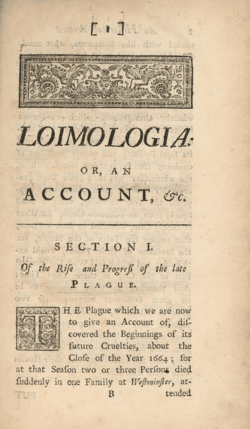
Loimologia
Encyclopedia

Nathaniel Hodges
Nathaniel Hodges M.D. was an English physician, known for his work during the Great Plague of London and his written account Loimologia of it.-Early life:...
(1629–1688), originally published in London in Latin (Loimologia, sive, Pestis nuperæ apud populum Londinensem grassantis narratio historica) in 1672; an English translation was later published in London in 1720. The treatise provides a first-hand account of the Great Plague of London
Great Plague of London
The Great Plague was a massive outbreak of disease in the Kingdom of England that killed an estimated 100,000 people, 20% of London's population. The disease is identified as bubonic plague, an infection by the bacterium Yersinia pestis, transmitted through a flea vector...
; it has been described as the best medical record of the epidemic . While most physicians fled the city, including the renowned Thomas Sydenham
Thomas Sydenham
Thomas Sydenham was an English physician. He was born at Wynford Eagle in Dorset, where his father was a gentleman of property. His brother was Colonel William Sydenham. Thomas fought for the Parliament throughout the English Civil War, and, at its end, resumed his medical studies at Oxford...
, and Sir Edward Alston
Edward Alston
Sir Edward Alston , was the president of the College of Physicians.Alston was born in Suffolk, and was educated at St. John's College, Cambridge. He graduated B.A. 1615, M.D. 1626. In 1631 he was elected a fellow of the College of Physicians, and was president from 1655 until 1666. At the...
, president of the Royal College of Physicians
Royal College of Physicians
The Royal College of Physicians of London was founded in 1518 as the College of Physicians by royal charter of King Henry VIII in 1518 - the first medical institution in England to receive a royal charter...
, Hodges was one of the few physicians who remained in the city during 1665, to record observations and test the effectiveness of treatments against the plague . The book also contains statistics on the victims in each parish
Parish
A parish is a territorial unit historically under the pastoral care and clerical jurisdiction of one parish priest, who might be assisted in his pastoral duties by a curate or curates - also priests but not the parish priest - from a more or less central parish church with its associated organization...
.
The English translation (1720) was released while a plague was spreading throughout Marseilles, and people in England were fearful of another outbreak. To this 1720 edition was added An essay on the different causes of pestilential diseases, and how they become contagious ; with remarks on the infection now in France, and the most probable means to prevent its spreading here, by John Quincy
John Quincy (medical writer)
-Life:He was apprenticed to an apothecary, and afterwards practised medicine as an apothecary in London. He was a Dissenter and a Whig, a friend of Dr. Richard Mead, and an enemy of Dr. John Woodward. He studied mathematics and the philosophy of Isaac Newton. He died in 1722.-Works:He knew little...
.
Loimologia was one of the sources used by Daniel Defoe
Daniel Defoe
Daniel Defoe , born Daniel Foe, was an English trader, writer, journalist, and pamphleteer, who gained fame for his novel Robinson Crusoe. Defoe is notable for being one of the earliest proponents of the novel, as he helped to popularise the form in Britain and along with others such as Richardson,...
when writing A Journal of the Plague Year
A Journal of the Plague Year
A Journal of the Plague Year is a novel by Daniel Defoe, first published in March 1722.The novel is a fictionalised account of one man's experiences of the year 1665, in which the Great Plague struck the city of London...
(1722).

